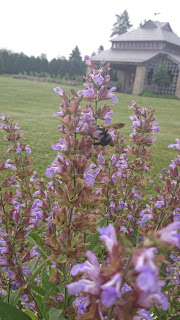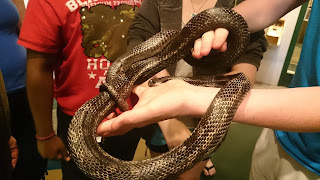Today in the "To the woods" intersession, we worked on a short story. The short story is about an animal, and we were supposed to personify and make it creative. I tried my best, and this is my short story.
Drake the Dragon
By: Jon Henry
 At the beginning,
Drake the dragonfly is just a mere egg. He is laid by his mother on top of the
plants in the small pond, the same pond where he will find his home at for the
majority of his life. The pond itself is nothing special, it is very murky and
is thriving with insects. While it’s early spring this year, the mating of all
the insects is occurring and laying their eggs in the water. After a couple
days after his mother lays him he hatches. He immediately realizes that he’s
not alone and must act fast. There are hundreds of other larvae, and he knows he
must compete with them. “Gotta eat! Gotta hide! Gotta eat! Gotta hide!” In his
alien-like nymph form, Drake swims around and tries to find his food, for he
knows that if he doesn’t get any soon, he will soon die. He eats other
dragonfly larvae that are late to hatching and he eats other insects that live
inside of the pond. Drake swims around, blowing himself around like a Jet Ski while
eating and hiding from predators.
At the beginning,
Drake the dragonfly is just a mere egg. He is laid by his mother on top of the
plants in the small pond, the same pond where he will find his home at for the
majority of his life. The pond itself is nothing special, it is very murky and
is thriving with insects. While it’s early spring this year, the mating of all
the insects is occurring and laying their eggs in the water. After a couple
days after his mother lays him he hatches. He immediately realizes that he’s
not alone and must act fast. There are hundreds of other larvae, and he knows he
must compete with them. “Gotta eat! Gotta hide! Gotta eat! Gotta hide!” In his
alien-like nymph form, Drake swims around and tries to find his food, for he
knows that if he doesn’t get any soon, he will soon die. He eats other
dragonfly larvae that are late to hatching and he eats other insects that live
inside of the pond. Drake swims around, blowing himself around like a Jet Ski while
eating and hiding from predators.
Drake goes through this process every single minute of every
single day. For days, months, years, he never stops. He constantly thinks “Food.
Need food. Need to hide. Which one is more important?” He lives every moment of
his life in the moment and doesn’t let anything pass him without seeing it. He doesn’t
have regrets, he doesn’t have grudges, he doesn’t have hates or loves. He
simply lives, and thinks about living, and everything he does is focused on
living.
After a 3-4 years of swimming through the water and growing
bigger and bigger, he finally starts to become ready to go into metamorphosis and
become an adult. “Just in time too! 3 years as a larva is very boring. I want
to fly now!” The weather has to be just right, so Drake has to wait when he’s
fully grown until he finds it suitable. It could take weeks until he is able to
find a good day to shed his skin on. He tries one day, “It’s too dry! Must go
back to water.” He tries the next day, “it’s way too hot! Must wait until it
cools down.” And then finally, the day comes. “Perfect! It’s not too hot, not
too dry, and perfectly humid.” Drake finds the stem of a nearby plant in the
pond and starts climbing it, and once he reaches the top he starts shedding his
skin and becomes a beautiful adult dragonfly. He emerges with black, wet wings
with white tips and a tad of purple. Big, black eyes that seem to be bigger
than his entire head. A long purple-black tail that gracefully fits with the
rest of his body. His eyes are the most valuable, because he uses 80% of their
brain on eyesight and he can almost see in a total 360 degree view. He is
always living in the moment, always seeing everything that’s going on, missing
nothing.
But right when he
sheds his skin is when he is also the most vulnerable. Drake’s wings are still
wet from shedding his previous skin, and will have to avoid predators while
still eating insects over the next few days if he wants to survive. “Yay! I’m
finally going to fly!!!” He flies around, and the first thing he wants to do is
eat. He wants to eat and reproduce, but he’s just so hungry, he hasn’t eaten in
hours! He tries and tries but can’t eat mosquitos and flies, they are too fast
for him due to his wet, newly formed wings. He finds out quickly that he needs
to find some way to overcome his challenge, so he tries to wait. He thinks
about trying to sneak up on the insects, but he is too big. He then flutters onto
a branch and waits patiently to see if something will come close enough for him
to eat.
But this was the wrong thing to do. “OH! Gotta move! Gotta move!”
Almost instantly, a bird that was perching above him swoops down with its beak
opened, hoping to have an easy lunch. But since Drake is so observant, he sees
this and quickly dodges right, and lowers himself to his pond, so he could see
if he could eat some of the insects that are on top of the pond. He is mere
inches above the water and the bird gives up and goes back to its nest. But
when he leaves one predator’s domain, he enters another’s. A frog sees drake
and uses its tongue to attempt to grab onto Drake’s wings and succeeds. Drake
ultimately lives to feed another. He leaves the world, his life, with no
regrets. He doesn’t resent anything he has done and knows that most dragonflies
die in his stage of life. He perishes, but he lived a happy life. He lived and
ate, and all he ever wanted was to live, which he did.












